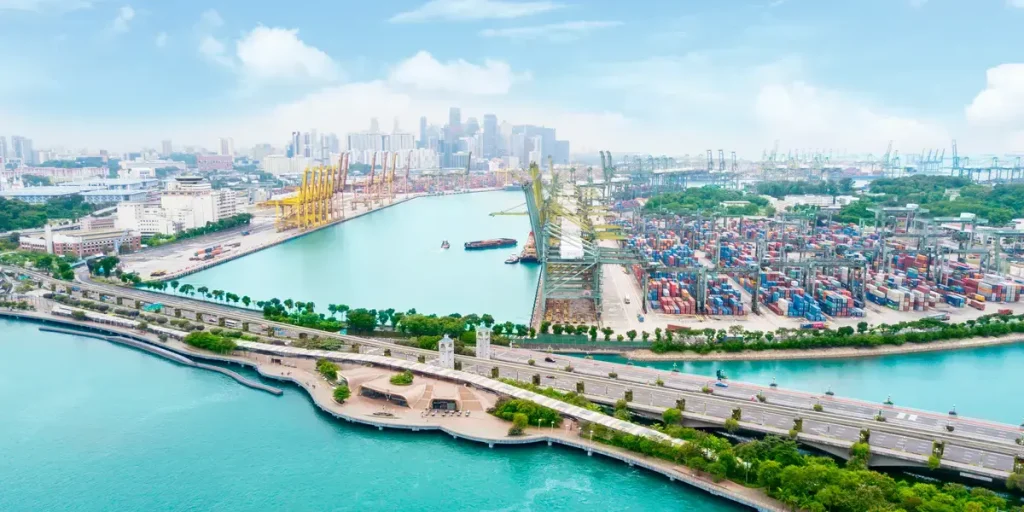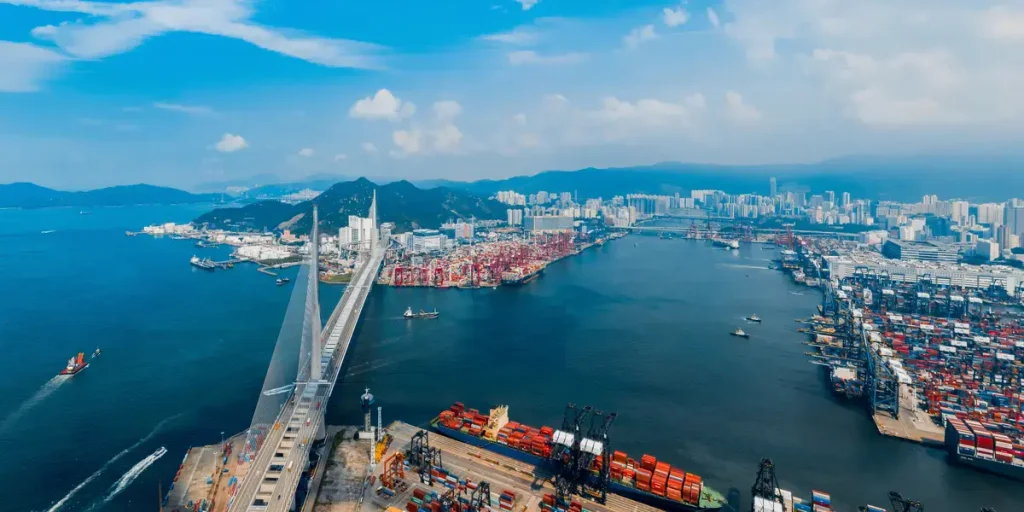Maritime trade has always been shaped by geography. From the earliest civilizations, merchants sought natural harbours where ships could load and unload safely, protected from storms and with easy access to inland routes. This is why the question “why are ports located near natural waterways considered advantageous?” has such a clear and enduring answer: natural waterways provide accessibility, protection, and efficiency.
Today, the same principles still hold true. Whether it’s Rotterdam at the mouth of the Rhine, Singapore at the crossroads of the Strait of Malacca, or New York in its deep natural bay, the world’s busiest ports owe their success to their geographic advantages. For shipowners, traders, and port agents, understanding these natural strengths is essential to ensure smooth operations and competitive logistics.
Strategic importance of natural waterways for port locations
The placement of ports is rarely accidental. Those established along natural waterways benefit from inherent geographical strengths that improve access, reduce costs, and offer environmental stability. These factors combine to make such locations more competitive in international trade.
Accessibility and connectivity to trade routes
Ports near rivers, gulfs, or straits are naturally integrated into major maritime highways. This accessibility reduces deviation times for ships and ensures continuous flows of goods. Think of Singapore, located along the Strait of Malacca, where over one-quarter of the world’s traded goods pass every year.

Cost efficiency in infrastructure and operations
Building a port is expensive, but nature often does much of the work. A naturally deep bay reduces the need for extensive dredging, and natural landforms can eliminate the necessity for massive breakwaters. This lowers both initial investments and ongoing maintenance costs, making operations more efficient for shipowners and terminal operators alike.
Environmental and geographical advantages
Geography itself becomes an ally: estuaries provide calm waters, gulfs offer protection from the open sea, and surrounding land often provides the space for terminals, warehouses, and multimodal transport connections. These conditions are far harder to replicate in artificially created ports.
Harbours in deep gulfs and bays: why location matters
Ports located within gulfs and bays stand out for the natural conditions that make them safe and efficient. Their depth, shelter, and maneuvering space give them a clear operational edge over exposed coastal sites.
Natural depth and reduced dredging needs
Large vessels require deep water to approach safely. Ports like Santos in Brazil or the Bay of Algeciras in Spain benefit from naturally deep approaches, reducing the need for costly dredging and minimizing environmental disruption.
Protection from harsh marine conditions
Bays provide a natural shield against strong waves, winds, and currents. This makes them safer for berthing, cargo handling, and year-round operations. For example, the Port of Hong Kong is renowned for its natural shelter, which has supported its growth into one of the busiest container ports in the world.

Safe anchorage and maneuverability for large vessels
Wide gulfs allow vessels space to anchor and maneuver. With the rise of mega-ships like Ultra Large Container Vessels (ULCVs), this natural maneuverability is invaluable. Deep gulfs and wide bays allow tugs and pilots to handle ships safely, reducing operational risks.
Advantages of water transport
Water transport remains the backbone of global trade, and not only because of history. Its technical and economic benefits make it the most suitable mode for moving massive cargo volumes across oceans and inland waterways.
High cargo capacity and energy efficiency
Ships can carry far more cargo than trucks, trains, or planes. Moreover, fuel consumption per tonne of cargo moved is significantly lower, making shipping the most energy-efficient transport mode.
Lower transportation costs for bulk goods
For bulk commodities like coal, iron ore, or grain, shipping costs are unbeatable. It is not a coincidence that global trade in these goods has boomed thanks to vessel classes like Capesize bulkers and Panamax ships, designed to maximize economies of scale.
Reduced environmental footprint compared to road or air
Although shipping faces challenges in decarbonization, its emissions per tonne-kilometre remain lower than those of trucks or airplanes. As IMO regulations push for cleaner fuels and efficiency measures, water transport is becoming even more environmentally competitive.
Disadvantages of water transport
Despite its strengths, shipping also comes with challenges that influence logistics planning. Understanding these drawbacks is essential for balancing waterborne trade with other modes of transport.
Slower transit times and limited speed
Ships cannot compete with planes for speed. Container ships average 18–22 knots (33–41 km/h), meaning transoceanic voyages can take weeks. For urgent or perishable goods, this is a clear disadvantage.
Dependency on weather and seasonal variations
Shipping remains vulnerable to nature. Monsoons, hurricanes, ice, or river droughts can halt operations. For example, low water levels in the Rhine River have repeatedly disrupted Europe’s inland shipping, highlighting how seasonal changes affect trade.
Infrastructure limitations in remote regions
Even where waterways exist, not all regions have the infrastructure—cranes, terminals, warehouses—to support efficient shipping. Remote areas may rely on smaller ports or even lightering operations, which add costs and risks.
Waterways as transport routes: pros and cons
When assessing waterways as transport routes, the balance between pros and cons becomes clear. On the one hand, they provide unmatched efficiency, scale, and environmental advantages. On the other, reliance on weather, seasonal conditions, and infrastructure constraints means waterborne transport must often be integrated with road and rail to ensure reliability.
For port agents, this duality reinforces the importance of expertise. Efficient coordination, proactive planning, and knowledge of both port and vessel limitations are what transform the potential advantages of natural waterways into real, tangible benefits for shipowners and traders.
Comparison: Natural vs Artificial port locations
Not all ports enjoy the same natural conditions. Some are shaped entirely by geography, while others depend on human engineering to function. Comparing both helps illustrate why natural waterways have historically been the preferred choice.
| Aspect | Natural Ports (Bays, Gulfs, Rivers) | Artificial Ports (Man-made Infrastructure) |
| Depth | Naturally deep, minimal dredging | Requires frequent dredging to maintain depth |
| Shelter | Protected by geography (bays, headlands, estuaries) | Needs costly breakwaters and sea walls |
| Cost efficiency | Lower construction and maintenance costs | Higher upfront and ongoing costs |
| Accessibility | Often integrated into major trade routes | May need artificial channels and diversions |
| Environmental impact | Minimal alteration to natural landscape | High impact from dredging and coastal modification |
| Operational flexibility | Large space for anchorage and vessel maneuverability | Constrained by artificial layout and space limits |
Turning geography into a strategic advantage
So, why are ports located near natural waterways considered advantageous? Because natural geography provides what artificial engineering must struggle to replicate: depth, protection, accessibility, and efficiency. Ports situated in bays, gulfs, or rivers not only reduce operational costs but also provide safer, more reliable conditions for ships of all sizes.
That is not to say artificial ports are unimportant—on the contrary, they are essential in regions lacking natural advantages. Yet the greatest maritime hubs, from Rotterdam to Singapore, have flourished precisely because they were built on waterways that gave them a natural edge.
For today’s shipping professionals, understanding these advantages is not theoretical—it is a practical necessity. Port agents, in particular, ensure that the natural benefits of waterways are fully leveraged while mitigating operational risks. At Ibérica Marítima, as ship agent, we specialize in protecting our clients’ interests, ensuring safe and efficient port operations, and turning the natural advantages of geography into real commercial success.
Because in maritime trade, the question is not only where a port is built, but how it is managed.


